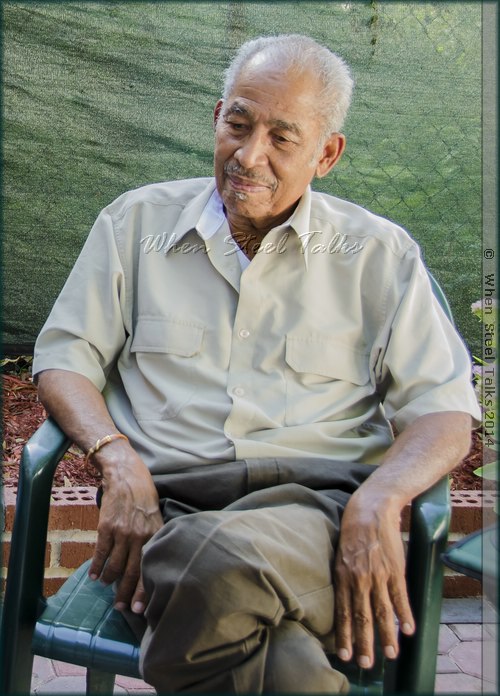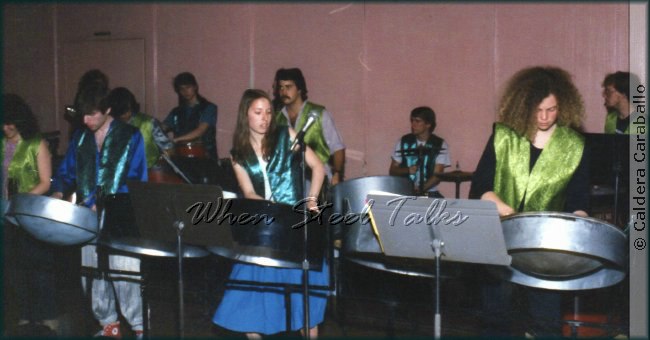
“....In 1985 Caldera Caraballo brought together the Brooklyn
Philharmonic and Trinidad & Tobago’s Casablanca Steel Orchestra to
perform at BAM (Brooklyn Academy Music)” on
December 14 & 15....
Global - Meet Caldera Caraballo, as he takes us through his wonderful, often colorful and captivating journey with the steelpan instrument, from a youth in Trinidad with the storied Casablanca Steel Orchestra - to successful entrepreneur and promoter of the steelband artform in the United States. In this exclusive When Steel Talks (WST) interview, many years later still enchanted with the steelpan instrument, Caldera reflects on and relives for the WST global steelpan community - the ups, downs, the joys, pains, disappointments and satisfaction he has experienced with Pan.

Caldera
Caraballo
Even now after significant time has passed, the scars, wounds and hurts are still fresh and can be openly seen in Caldera’s facial expressions as he shares memories of some of his experiences. Caldera reveals that “There was a time I didn’t want to ever talk to a steelband man again.” Indeed such was his disillusion with the steelpan fraternity. The depth of lows and sacrifices he suffered in regards to the steelpan movement are too real. However - resilience, steadfastness and support from his wife Louise, family and friends have allowed him to recover and now reflect on his achievements and place in the history of Pan - a status a very select few have known. Caldera’s place in the annals of steelpan history is unquestionable as he remains the linchpin and significant cog in the wheel that binds the beginning of, yesteryear and Pan today in the USA.
Always with a vision of something better and higher from an early age, he was part of the formation of City Syncopators in Trinidad as he and the younger faction of Casablanca broke away from their parent organization. His résumé is punctuated with many “firsts,” several of which that have not ever been repeated since he accomplished them, sadly. The writing and performance of his tune “Caldera’s Mambo” in 1955 was—at the time—the only calypso performed that was composed by a steelband person - and incidentally also how he came by his name. A few years later he would be part of a weekly show at Carnegie Hall where he performed with Rudolph (Rudy) King. And as a soloist he toured with Harry Belafonte.

Caldera
Caraballo
& Carlos
Lezama (the
late president
of WIADCA)
Caldera lets us know that he comes to America in 1956 by way of Argentina - by sea - and as he tells the story “I got here in the day at about eleven o’clock and by seven o’clock I was in a panyard practicing with Rudolph King.” They were practicing for a steelband competition. Rudolph (Rudy) King of course is the man who brought the steelpan to America.
King and Caldera were old buddies from Trinidad. Needless to say they won the competition with their controversial performance of “God Bless America.” And as Caldera so humorously puts it - “Even though there were those who thought they should not have won, “the judges were ‘patriots’.” Caldera and crew had just snatched victory from none other than a youthful Andy Narell and the Steel Bandits - the apparently expectant and preferred winners of the competition organizers. To appease the others who lost they decided to divide their winnings equally with them. In the band were Caldera, Lennox Leverock, Roy Sangster, Courtney Proctor, Fitzroy James and of course Rudy King.
Caldera feels he may have stepped on the toes of some important people and that led to some of the difficulties he experienced, as many of his supporters in ‘high places’ went from friends to foes. Caldera also speaks of his State department and CIA interactions relative to some steelband players, which at an event included daughters of US Congress members.

Pan players
from Oberlin,
including
daughters
of US Congress
members

Caldera
Caraballo
with the
late Anthony
Prospect
(seated)
backstage
at BAM (Brooklyn
Academy
of Music)
in December
1985.
As musical
director
and conductor,
Prospect
travelled
with Casablanca
Steel Orchestra,
which performed
with the
Brooklyn
Philharmonic
in
concert.
Caldera sadly laments his personal belief that the steelband movement has regressed. He feels the main focus of the bands currently is Panorama - which he started at WIADCA (West Indian American Day Carnival Association) in the early 70s with five bands inclusive of (Sonatas, Tropicans, Brooklynaires, Harlem All-Stars). In addition, Caldera is of the opinion that important people in the history of the development of Pan in the US have been forgotten or written out of history; names like “Mullyket,” Pops McCarthy, “Holdip,” Milton Gabriel, “Patsy” Haynes, Fitzroy James—to name a few—and, unfortunately several who have since passed.
He founded the National Council of Steelbands and brought Casablanca, Exodus, Invaders and Tokyo steel orchestras from Trinidad to America. He also produced steelband concerts with these bands at the Brooklyn Academy of Music, Lincoln Center and Carnegie Hall among other places. He was elected the first chairman of Pan Trinbago Northern Region in the USA.
Never given full credit or acknowledged for his many roles and accomplishments for US Pan, Caldera Caraballo remains a man under-appreciated and misunderstood for the lofty goals and high expectations he had for Pan in America. He remains a man with a vision and a plan who was ahead of his time.

Then-Pan
Trinbago
president
Arnim Smith,
left; Caldera
Caraballo
is third
from left,
then Ken
Gordon and
Ms. World
1986 Giselle
Laronde.
Occasion:
Inauguration
of the short-lived
Pan Trinbago
North American
Region subsequently
headed by
Caraballo;
event was
held at
United Nations
headquarters
in New York
From
the archives
of Caldera
Caraballo
National Council of Steel Bands
SUMMARY
HISTORY
The steelband originated in Trinidad & Tobago in the early forties. The evolution of the steel pan or steel drum was the result of the tinkering and experimentation of idle but talented youths with discarded steel oil drums. They discovered that by creating various convex shapes in the tops of the drums different melodies and tones could be created.
It is said that the first time a steel drum player made a complete musical melody was in early 1945. It was the end of WW II, and as the celebration continued, drums of all sizes and shapes began to appear. From that time on the pan developed and improved in design and quickly came to be called a musical instrument.
In the early fifties steelbands began to tour North America as orchestras, playing concert halls, theatres, etc, and offering many programs to encourage youths to learn the technique of playing this innovative new instrument which has the capacity to simulate the tones of such traditional classical instruments as the violin, viola and string bass.
In 1956, Reynold “Caldera” Caraballo, immigrated to the United States from his native Trinidad. Although Caldera readily embraced America as his new home, he never forgot the culture and exhilarating music that so enriched his life in Trinidad. Further, he was anxious to share this rich heritage with all of North America. In the late fifties he entertained thousands of enthusiastic listeners in such halls as Radio City Music Hall, the Roxy Theatre and Carnegie Hall in New York City, with vibrant steel band music. Encouraged by the reception he received in New York he then toured the United States: Hollywood, Las Vegas, Minneapolis, Chicago, Washington, D.C., etc. He attracted the attention of Harry Belafonte and became part of the Harry Belafonte Enterprises, which also toured the United States and Canada. It was in Toronto that the audience and critics raved about the music, then so foreign to their ears.

Caldera
Caraballo
In the sixties Caldera, now quite well known, opened in Brooklyn the first school for steel band music outside of Trinidad. Though not a tremendous financial success, it did also serve as a vehicle for helping immigrants from Trinidad to assimilate and find employment. In the seventies, Caldera was elected the Steelband Coordinator for the West Indian American Day Association/West Indian Labor Day Parade. In the eighties he formed and chaired the NATIONAL COUNCIL OF STEEL BANDS. He was recently elected as chairman of the Pan Trinbago North America & Canada, an external branch of Trinidad & Tobago’s largest steel band association.
More on Caldera Caraballo
Leave your comment in the WST forum



